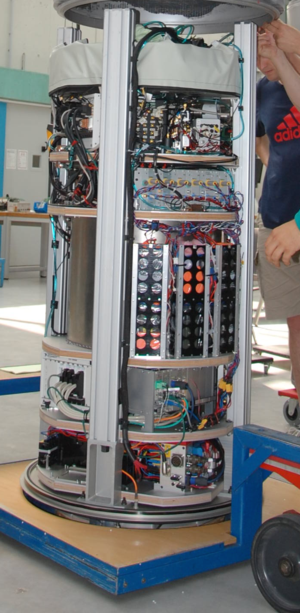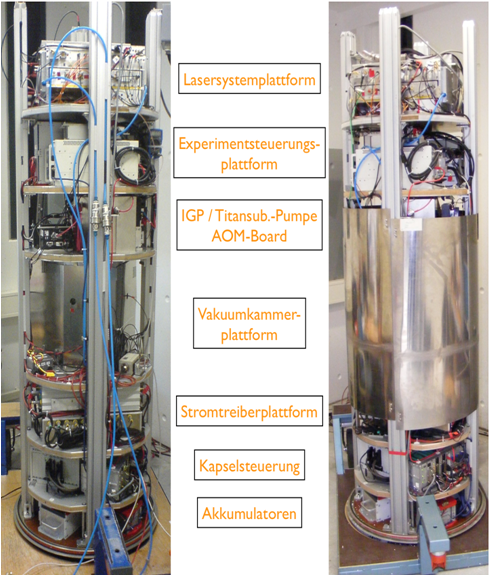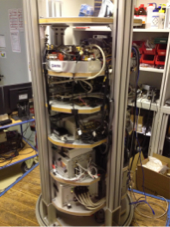ultracold macroscopic quantum systems in weightlessness (QUANTUS) - Bose-Einstein Condensates in weightlessness

research area: fundamental physics
experiment title:
Ultracold macroscopic quantum systems in weightlessness (QUANTUS) - Bose-Einstein Condensates in weightlessness
experiment acronym:
QUANTUS I / QUANTUS II
funding agency: DLR
grant number:
50WM0346 (2004 - 2007), 50WM0836 (2008 - 2010), 50WM1135 (2011 - 2014), 50WM1555
performing organization:
Institut für Quantenoptik (IQO), Leibniz Universität Hannover /
ZARM, Universität Bremen /
DLR - Institut für Raumfahrtsysteme, Bremen /
Institut für Laserphysik, Universität Hamburg /
Institut für Physik, AG Optische Metrologie (QOM), Humboldt-Universität zu Berlin /
Midlands Ultracold Atom Research Centre, Birmingham (UK) /
Max-Planck-Institut für Quantenoptik (MPQ), München /
Laboratoire Kastler-Brossel de l’Ecole Normale Supérieure, Paris (F)
/ Institut für Quantenphysik, Universität Ulm /
Institut für angew. Physik, TU Darmstadt
prime investigator:
Ernst M. Rasel, Wolfgang Ertmer / Claus Lämmerzahl / Hansjörg Dittus /
Klaus Sengstock / Achim Peters / Kai Bongs / T. W. Hänsch / J. Reichel /
Wolfgang P. Schleich / Reinhold Walser
experiment objective
abstract
Physics based on laser cooled atomic ensembles and quantum degenerate gases, such as Bose-Einstein Condensates (BEC), became a fast growing field of research since the first realization of a Bose-Einstein Condensate with a dilute gas of atoms in 1995. Many quantum mechanical phenomena like matter waves interferences, superfluidity, solitons or Bloch-oscillations are research subjects in various laboratories worldwide. On the field of quantum sensors, condensates can serve as an ideal coherent atomic source. These quantum sensors have promising applications ranging from geodesy over metrology up to fundamental questions as tests of the equivalence principle. Inertial sensors can be realized with free-falling atoms, whereas the sensitivity increases with the quadratic time of flight. An increase of the sensitivity in this way gives the need of environments with low vibrations and of minimizing the energy to unprecedented temperatures. Microgravity offers the advantage of unequaled regimes of coldest temperatures, macroscopic dimensions of matter waves and longest free evolution of the condensate on the time scale of seconds.
Within the QUANTUS pilot project an experiment for the implementation of a Bose-Einstein Condensate in microgravity was designed and constructed followed by the realization of the first BEC in weightlessness. The drop tower in Bremen was chosen to be the most ideal platform, since there is a relatively easy access to the experiment, excellent micro-gravitational conditions, 4.74 seconds of free fall and a repetition rate of up to three drops per day. The restrictions on the usable space, the available power of the battery, the maximum weight and the exigency of a remote controlled system are basic conditions, that make this apparatus a prototype of a mobile BEC experiment implementable in ballistic rockets or space missions like on board the ISS.
The realization of the first BEC in microgravity on November 13th, 2007 was followed by the first free evolution of a condensate in the time domain of 1 second. This experiment could open new roads for applications especially in the field of atom interferometers. The interplay of a high sensitive optical systems and quantum optics on the one hand and a compact, robust and remote controlled experiment on the other hand was shown.
Within the QUANTUS II experiment a further step forward in technology development and science with cold atoms was made. The initial QUANTUS experiment and its successors are still on-going projects with very promising scientific results and future applications on earth and in space.
related publications
- A. Vogel, M. Schmidt, K. Sengstock, K. Bongs, W. Lewoczko-Adamczyk, T. Schuldt, A. Peters, T. van Zoest, W. Ertmer, E.M. Rasel, T. Steinmetz, J. Reichel, T. Könemann, W. Brinkmann, E. Göklü, C. Lämmerzahl, H. Dittus, G. Nandi, W.P. Schleich, and R. Walser: Bose-Einstein Condensates in Microgravity, Applied Physics B: Lasers and Optics 84, 663-671 (2006)
- W. Ertmer, E.M. Rasel for the QUANTUS-Team: Towards Atomic Quantum Sensors in Microgravity, Nuclear Physics B - Proceedings Supplements 166, 307-309 (2007)
- T. van Zoest, N. Gaaloul, Y. Singh, H. Ahlers, W. Herr, S. T. Seidel, W. Ertmer, E. Rasel, M. Eckart, E. Kajari, S. Arnold, G. Nandi, W. P. Schleich, R. Walser, A. Vogel, K. Sengstock, K. Bongs, W. Lewoczko-Adamczyk, M. Schiemangk, T. Schuldt, A. Peters, T. Könemann, H. Müntinga, C. Lämmerzahl, H. Dittus, T. Steinmetz, T. W. Hänsch, J. Reichel: Bose-Einstein Condensation in Microgravity, Science 328, 1540 (2010).
- J. Rudolph, N. Gaaloul, Y. Singh, H. Ahlers, W. Herr, T. A. Schulze, S. T. Seidel, C. Rode, V. Schkolnik, W. Ertmer, E. M. Rasel, H. Müntinga, T. Könemann, A. Resch, S. Herrmann, C. Lämmerzahl, T. v. Zoest, H. Dittus, A. Vogel, A. Wenzlawski, K. Sengstock, N. Meyer, K. Bongs, M. Krutzik, W. Lewoczko-Adamczyk, M. Schiemangk, A. Peters, M. Eckart, E. Kajari, S. Arnold, G. Nandi, W. P. Schleich, R. Walser, T. Steinmetz, T.W. Hänsch, J. Reichel: Degenerate Quantum Gases in Microgravity, Microgravity Sci. Technol. 23, 287 (2011)
- S. Herrmann, H. Dittus, C. Lämmerzahl: Testing the equivalence principle with atomic interferometry, Class. Quantum Grav. 29, 184003 (2012)
- H. Müntinga, H. Ahlers, M. Krutzik, A. Wenzlawski, S. Arnold, D. Becker, K. Bongs, H. Dittus, H. Duncker, N. Gaaloul, C. Gherasim, E. Giese, C. Grzeschik, T. W. Hänsch, O. Hellmig, W. Herr, S. Herrmann, E. Kajari, S. Kleinert, C. Lämmerzahl, W. Lewoczko-Adamczyk, J. Malcolm, N. Meyer, R. Nolte, A. Peters, M. Popp, J. Reichel, A. Roura, J. Rudolph, M. Schiemangk, M. Schneider, S.T. Seidel, K. Sengstock, V. Tamma, T. Valenzuela, A. Vogel, R. Walser, T. Wendrich, P. Windpassinger, W. Zeller, T. van Zoest, W. Ertmer, W.P. Schleich, E.M. Rasel: Interferometry with Bose-Einstein Condensates in Microgravity, Phys. Rev. Lett. 110, 093602 (2013)
- J. Rudolph, W. Herr, C. Grzeschik, T. Sternke, A. Grote, M. Popp, D. Becker, H. Müntinga, H. Ahlers, A. Peters, C. Lämmerzahl, K. Sengstock, N. Gaaloul, W. Ertmer and E.M. Rasel: A high-flux BEC source for mobile atom interferometers, New J. Phys. 17 (2015)
- H. Ahlers, H. Müntinga, A. Wenzlawski, M. Krutzik, G. Tackmann, S. Abend, N. Gaaloul, E. Giese, A. Roura, R. Kuhl, C. Lämmerzahl, A. Peters, P. Windpassinger, K. Sengstock, W. P. Schleich, W. Ertmer, and E. M. Rasel: Double Bragg Interferometry, Phys. Rev. Lett. 116 173601 (2016)
- S. Abend, M. Gebbe, M. Gersemann, H. Ahlers, H. Müntinga, E. Giese, N. Gaaloul, C. Schubert, C. Lämmerzahl, W. Ertmer, W. P. Schleich, and E. M. Rasel: Atom-Chip Fountain Gravimeter, Phys. Rev. Lett. 117 203003 (2016)
experimental setup



experiment campaigns
QUANTUS II (Laser Tests)
experiment year: 2018
number of catapult launches: 9
QUANTUS II
experiment year: 2020
number of drops: 55
experiment year: 2018
number of drops: 58
experiment year: 2017
number of drops: 3
experiment year: 2016
number of drops: 28
experiment year: 2015
number of drops: 136
experiment year: 2014
number of drops: 48
number of catapult launches: 9
experiment year: 2013
number of catapult launches: 2
QUANTUS I
experiment year: 2013
number of drops: 15
experiment year: 2012
number of drops: 96
experiment year: 2011
number of drops: 114
experiment year: 2010
number of drops: 23
experiment year: 2009
number of drops: 30
experiment year: 2008
number of drops: 155
experiment year: 2007
number of drops: 41
experiment year: 2005
number of drops: 2
experiment year: 2004
number of drops: 3


 "
"